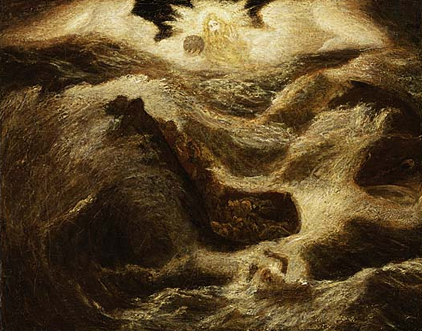The Spouter Inn, New Bedford, in Melville's Moby Dick, had on its wall a strange painting, ''thoroughly besmoked, and every way defaced'', with such ''unaccountable masses of shades and shadows, that at first you almost thought some ambitious young artist, in the time of the England hags, had endeavoured to de-lineate chaos bewitched.'' It was ''a boggy, soggy, squitchy picture truly, enough to drive a man distracted.''
Albert Pinkham Ryder (1847-1917) was four years old when Moby Dick was published. Born and raised in New Bedford, he was something of an oddity: a painter who seems to have spent his entire life attempting to realise that one murky figment of Melville's imagination. There are around 40 Ryders currently on view upstairs at the Whitechapel Art Gallery. Tiny, bitumenised, inchoate pictures, they make a startling contrast to the large, bright landscapes by Michael Andrews (reviewed in this column last week) hung on the ground floor. Boggy, soggy, squitchy pictures truly.
Jonah, often said to be Ryder's masterpiece, treats a theme close to Melville's heart, and comes as close as anything in his oeuvre to that fictive painting in Moby Dick. The figures in Ryder's picture, where you can make them out, are so badly rendered that they are comical. Jonah, struggling among the waves, is a piece of human fudge; God appears to be blessing a Christmas pudding over the horizon. They are suspended in something very like the ''nameless yeast'' to which Melville compares the texture of the Spouter Inn painting.
Ryder is known to have used dirt scraped from his boots, candle wax and tobacco juice from the large spittoon in his studio to create the unusual, ruinous appearance of his pictures. At least a third of the pictures on display are now all but indecipherable.
Even in Ryder's...


